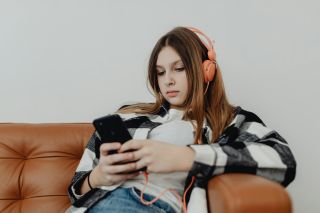Media
Are Screens Really to Blame for Teens' Struggles?
On the relation between screen use and mental health.
Posted August 19, 2024 Reviewed by Devon Frye
My kids are obsessed with their screens. They love playing games on their tablets, and they look over my shoulder whenever I’m scrolling social media to see the latest funny video about dogs jumping in pools.
Obviously, things were different when I was a kid. Being born in 1980, I’m right at the end of Generation X, which includes those of us who were born between 1965 and 1980. Gen X kids were the last to grow up almost completely without smartphones and the internet. We had landlines, big heavy televisions, VCRs, cassette tapes, and CDs.
The generations that followed were largely surrounded by all of the information that the internet can provide, most from a young age. These days, kids can pause a show if they need to go to the bathroom and get a snack (while we had to run back and forth during commercials); they can ask a device to play whatever song they want to hear or whatever show they feel like watching. My kids—who are 6 and 9 years old—don’t get why I can’t skip a song they don’t like on the radio, or why old-fashioned phones don’t have touchscreens.
Based on all of this change, one question that scientists have been asking is how the internet and the availability of screens have changed the way we think and feel. In other words, how are the Baby Boomers and Gen X different from the generations that followed? Is all of this screen time bad for us, and especially bad for our kids?

I think many parents, including me, feel in our guts that too much screen time can’t be good—for us or our kids. A recent book by Jonathan Haidt, The Anxious Generation: How the Great Rewiring of Childhood is Causing an Epidemic of Mental Illness, has brought many of these issues right into the spotlight.
In the book, he discusses research on screen time and social media in particular and examines how it relates to kids’ mental health. The conclusions he draws from these data seem to make our worst fears a reality: Social media, he argues, or what he calls “the great rewiring” has led to a myriad of social and emotional problems for kids, starting with spikes in depression and anxiety, and even leading to a rise in suicide rates amount adolescents.
This book and similar ones that he draws on, like iGen: Why Today’s Super-Connected Kids are Growing up Less Rebellious, More Tolerant, Less Happy and Completely Unprepared for Adulthood, and What it Means for the Rest of Us by Jean Twenge make the case that being raised with the internet and social media at an early age has led to major increases in mental health problems for kids and teens. These arguments have received a barrage of media coverage, leaving a lot of parents besides themselves, fearing the worst every time their kids pick up a cell phone or tablet.
The Evidence
The first question you might be asking is: What evidence do Haidt, Twenge, and many others use to conclude that media use is so bad? Much of the data comes from a series of large datasets based on questionnaires that kids and adults fill out to track screen use, mental health, and a variety of other factors over time.
Twenge specifically relies on four very large datasets that have tracked basic media use and mental health trends since the 1970s. What these data show is a shift in mental health issues in the U.S. and other countries like Canada and the UK starting around the years 2010 to 2015, which happen to be around the same time that the first iPhone came out (2007), the birth of Facebook (2004), Instagram (2010), and Twitter (2006). They both report that screen use and mental health issues like anxiety and depression are related, or correlated, meaning that the ups and downs in one follow the ups and downs in the other.
However, their conclusions have been criticized by other researchers who argue that just because two things like screen use and mental health fluctuate together doesn’t mean that a change in one causes a change in the other. Indeed, I love to show a graph in my statistics lectures showing that there is a strong relation between the number of films that Nicholas Cage has appeared in and the number of female editors of the Harvard Law Review. Do we really think Nick Cage's appearance in movies causes more female lawyers to become editors? No, we don’t, but the relation is there, nonetheless.
What’s perhaps more problematic is that other researchers have analyzed similarly large datasets (and sometimes the very same ones) and have concluded that the relation between media use and mental health problems does exist, but it is very small—too small, in fact, to hold any practical value (see Cavanagh, 2019).
One study that analyzed two of these large datasets showed, for example, that the impact of smoking marijuana and bullying have a much larger negative association with adolescent well-being than does screen use, and that the association between emotional well-being and regularly eating potatoes was similar in size. In fact, they found wearing glasses had more of a negative impact on emotional well-being in adolescents than did screen use (Orben & Przybylski, 2019).
In his book, Haidt addressed this issue by reanalyzing the same dataset along with Jean Twenge, this time only looking at social media use (instead of screen use more broadly) and found that the relation between social media use and mental health was there, but it was small—until you removed boys from the equation. When only looking at girls, Haidt reported there is a much stronger relation between hours of social media use and depression, more akin to the impact of alcohol and marijuana use (Haidt, 2024).
Altogether, this suggests that the links between screen use and mental health outcomes are a bit more nuanced than what the media might suggest given that the relation is very small, and seems to be specific to social media use in girls. Indeed, other studies have provided mixed findings, suggesting that social media can be beneficial to mental health when it is used to make meaningful social connections, and harmful when it induces isolation.
In other words, activities on social media can promote mental health outcomes if they increase feelings of belonging but can be bad if social media behavior mostly manifests in lurking on other people’s profiles instead of interacting with friends, or if we use it to compare ourselves to others (Clark et al., 2018). Honestly, comparing our real lives to the highly curated lives we see on social media can make anyone feel like they are coming up short.
Studies add further evidence that this is the case, suggesting that negative social media behaviors like increased social comparison and compulsive use are associated with more depression, while positive social media behaviors such as social interaction with others are associated with less depression (Robinson et al., 2018). This suggests that it’s not the quantity of social media teens are consuming, it is the quality that predicts outcomes.
Further, it suggests that we need a more nuanced approach to thinking about how media use impacts mental health, and how children’s age, the content, and even changes to the internet itself might be driving both positive and negative outcomes.
What Do We Do?
Unfortunately, although we all like to keep things simple, the science on media use is anything but. So what do we do—both as parents and as media users?
First, you don’t have to throw away all of your phones or tablets. Haidt and Twenge argue that the reason we are experiencing a mental health crisis in adolescents is because of the rise in screen use, especially social media. As far as my read on the data, life is way too complicated to be this simple. The only strong data linking screen use to mental health issues is again with social media use specifically in teenage girls. However, anxiety and depression are on the rise in boys and adults too, so it seems unlikely that social media is doing all of the work by itself.
But although the data don’t necessarily provide a super strong link between screens and mental health issues, that doesn’t mean some of the data don’t hold weight. Indeed, it does suggest that teenage girls might be most vulnerable to the pitfalls of social media.
Further, there are studies demonstrating that limiting engagement with social media does reduce feelings of depression and loneliness (Hunt et al., 2018) so maybe some limitations on usage are called for. And while moderate media use (about 1 to 1.5 hours a day) does not seem to negatively impact well-being, several hours of use a day does have a negative impact, albeit small.
And regardless of how you want to take the data, the recommendations that come out of Haidt’s book appear sensible. Specifically, he recommends no smartphones before high school, no social media before age 16, encouraging phone-free schools, and more unsupervised play and childhood independence (Haidt, pg. 290).
I’m in favor of all of those. My only caveat here would be that since screens are likely not the only cause of the rise in mental health issues in children and adults, perhaps the focus shouldn’t be on just taking things (like screens) away.
Instead, a more effective strategy might be providing more opportunities for kids to engage with each other socially, in person, without parents hovering over them. In other words, although three of Haidt’s main recommendations focus on limiting screens, I would recommend putting more of the focus on his final recommendation—on encouraging more unsupervised play and childhood independence.
Indeed, what may be most problematic about social media is that it is taking the place of in-person social interactions, which are so very important for child and adolescent development. This suggests that the cause of all of this may not be screens per se, but instead, what screens are taking the place of.
We all know that kids (and a lot of American adults) are going to be more responsive to a list of new things they can do than a list of things they can’t. So yes, let’s lean out a bit on screen use, but more importantly, let’s lean in on encouraging more face-to-face social interactions offline, in person, where kids can learn to be independent and take social risks. These social interactions are what build an independent, mature, socially competent, and happy adult, regardless of what their Instagram feed shows you.
Facebook/LinkedIn image: Lopolo/Shutterstock
References
Cavanagh, S. R. (2019). Hivemind: The new science of tribalism in our divided world. Grand Central Publishing.
Clark, J. L., Algoe, S. B., & Green, M. C. (2018). Social network sites and well-being: The role of social connection. Current Directions in Psychological Science, 27(1), 32-37.
Haidt, J. (2024). The anxious generation: How the great rewiring of childhood is causing an epidemic of mental illness. Random House.
Hunt, M. G., Marx, R., Lipson, C., & Young, J. (2018). No more FOMO: Limiting social media decreases loneliness and depression. Journal of Social and Clinical Psychology, 37(10), 751-768.
Orben, A., & Przybylski, A. K. (2019). The association between adolescent well-being and digital technology use. Nature human behaviour, 3(2), 173-182.
Przybylski, A. K., & Weinstein, N. (2017). A large-scale test of the goldilocks hypothesis: quantifying the relations between digital-screen use and the mental well-being of adolescents. Psychological science, 28(2), 204-215.
Robinson, A., Bonnette, A., Howard, K., Ceballos, N., Dailey, S., Lu, Y., & Grimes, T. (2019). Social comparisons, social media addiction, and social interaction: An examination of specific social media behaviors related to major depressive disorder in a millennial population. Journal of Applied Biobehavioral Research, 24(1), e12158.
Twenge, J. M. (2017). iGen: Why today's super-connected kids are growing up less rebellious, more tolerant, less happy--and completely unprepared for adulthood--and what that means for the rest of us. Simon and Schuster.




